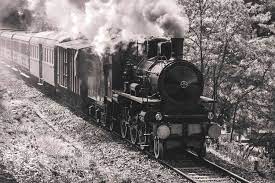
The Fascinating World of Railroads
Railroads have played a crucial role in shaping the world’s transportation systems for centuries. From the early steam locomotives to modern high-speed trains, railroads have connected people, cities, and industries in ways that have transformed societies and economies.
One of the key advantages of railroads is their efficiency in moving large volumes of goods and passengers over long distances. Trains can carry heavy loads that would be impractical for other modes of transport, making them essential for industries such as mining, agriculture, and manufacturing.
Moreover, railroads offer a sustainable mode of transportation, with lower carbon emissions compared to road or air travel. This makes trains a preferred choice for environmentally conscious travellers and businesses looking to reduce their carbon footprint.
Travelling by train also provides a unique experience, allowing passengers to enjoy scenic views and relax in comfortable surroundings. Many countries around the world have invested in high-speed rail networks that offer swift and efficient travel between major cities.
Despite facing challenges from other forms of transport, such as cars and planes, railroads continue to play a vital role in global transportation networks. The development of new technologies, such as maglev trains and automated systems, promises to further revolutionise the railroad industry in the years to come.
In conclusion, railroads remain an integral part of our modern world, offering efficient, sustainable, and enjoyable transportation options for both goods and passengers. As we look towards the future, it’s clear that the legacy of railroads will continue to shape how we move people and products across vast distances.
Exploring the Tracks: Key Questions Answered on the History, Operation, and Advantages of Railroads
- What is the history of railroads?
- How do trains operate on railroads?
- What are the benefits of travelling by train?
- How fast can trains travel on railroads?
- Are railroads a sustainable mode of transportation?
- What safety measures are in place on railroads?
What is the history of railroads?
The history of railroads dates back to the early 19th century when the first steam-powered locomotive was invented, revolutionising transportation. The development of railroads played a pivotal role in the Industrial Revolution, connecting cities and enabling the efficient movement of goods and people. Railways expanded rapidly across the UK and other countries, leading to economic growth and urban development. The construction of transcontinental railways in the 19th century further transformed trade and travel on a global scale. Today, the history of railroads stands as a testament to human ingenuity and innovation, shaping modern transportation systems and connecting communities worldwide.
How do trains operate on railroads?
Trains operate on railroads through a system of wheels and tracks that allow for smooth and efficient movement. The train’s wheels are designed to fit securely on the tracks, providing stability and guidance as the train travels along its route. The engine, typically located at the front of the train, generates power to propel the cars forward. As the wheels turn, they grip the rails and create friction, enabling the train to move along the track. Signals, switches, and control systems help regulate speed, direction changes, and ensure safe operation on the railroad network. Overall, trains operate on railroads through a combination of mechanical precision and strategic coordination to transport passengers and goods from one destination to another.
What are the benefits of travelling by train?
Travelling by train offers a multitude of benefits that make it a preferred mode of transportation for many passengers. One key advantage is the environmentally friendly nature of train travel, with lower carbon emissions compared to cars and planes, making it a more sustainable choice. Additionally, trains provide a comfortable and relaxing journey, allowing passengers to enjoy scenic views, spacious seating, and onboard amenities. Train travel is also known for its reliability and efficiency in reaching destinations on time, especially with the convenience of city-centre-to-city-centre connections. Overall, the benefits of travelling by train include eco-friendliness, comfort, reliability, and convenience, making it an appealing option for both leisure and business travellers alike.
How fast can trains travel on railroads?
Trains can travel at varying speeds on railroads, depending on factors such as the type of train, the track conditions, and the infrastructure in place. High-speed trains, such as those found in countries with advanced rail networks like Japan and France, can reach speeds exceeding 300 km/h (186 mph). In contrast, freight trains typically travel at lower speeds to ensure the safe transportation of goods. Overall, the speed at which trains can travel on railroads is determined by a combination of technological advancements, safety considerations, and operational requirements.
Are railroads a sustainable mode of transportation?
Railroads are widely regarded as a sustainable mode of transportation due to their lower carbon emissions compared to road or air travel. Trains have the capacity to move large volumes of goods and passengers efficiently over long distances, making them a key player in reducing overall transportation emissions. Additionally, the development of high-speed rail networks in many countries has further enhanced the sustainability aspect of railroads by providing swift and eco-friendly travel options between major cities. Overall, railroads offer a greener alternative for both individuals and businesses looking to lessen their environmental impact while enjoying the benefits of efficient and scenic travel.
What safety measures are in place on railroads?
Railroads implement a range of safety measures to ensure the well-being of passengers, employees, and the general public. These measures include rigorous training for railway staff, regular maintenance of tracks and equipment, strict adherence to signalling systems and speed limits, as well as the implementation of advanced safety technologies such as positive train control systems. Additionally, railroads conduct thorough inspections of tracks and bridges, employ safety protocols for hazardous materials transportation, and enforce strict regulations to prevent accidents and ensure the smooth operation of trains. By prioritising safety at every level, railroads aim to provide a secure and reliable transportation system for all who rely on their services.
